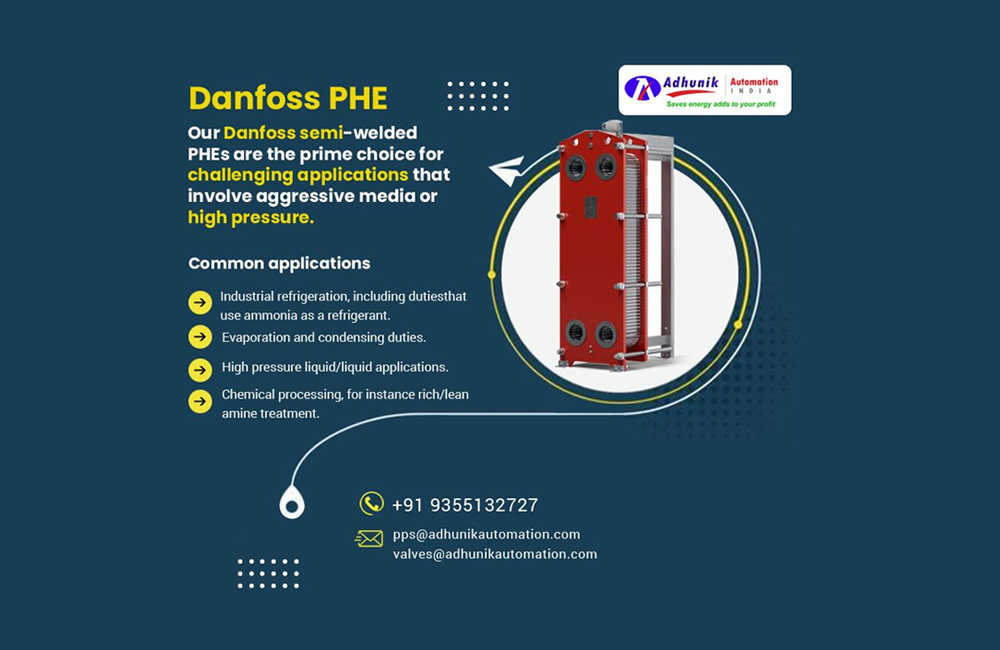Enhancing HVAC Efficiency with Plate Heat Exchangers (PHEs)

In today’s energy-conscious world, HVAC (Heating, Ventilation, and Air Conditioning) systems are expected to deliver not only comfort but also optimal energy performance. Among the various components that contribute to this performance, Plate Heat Exchangers (PHEs) have emerged as an essential element in modern HVAC design. With their superior heat transfer capabilities, compact size, and energy-saving potential, PHEs play a crucial role in ensuring efficiency, sustainability, and reliability.
What is a Plate Heat Exchanger (PHE)?
A Plate Heat Exchanger (PHE) is a type of heat exchanger that utilizes multiple thin, corrugated metal plates stacked together. These plates create a series of channels through which fluids flow. Heat is transferred from one fluid to another through the plate walls, allowing efficient temperature regulation without mixing the two fluids. The design promotes high heat transfer rates while maintaining a compact footprint, making PHEs ideal for various HVAC applications.
Applications of PHEs in HVAC Systems
PHEs are used extensively in HVAC systems across commercial, residential, and industrial settings. Their primary roles include:
- District Cooling and Heating: PHEs are commonly used to separate building HVAC systems from district energy networks. This isolation prevents cross-contamination and ensures safe and efficient energy transfer.
- Heat Recovery Systems: In buildings with ventilation systems, PHEs can reclaim heat from exhaust air and use it to preheat incoming fresh air. This not only reduces energy consumption but also improves indoor air quality.
- Hydronic System Separation: By separating primary and secondary loops, PHEs help maintain pressure and flow consistency, which is crucial for system stability and equipment longevity.
- Free Cooling Applications: During colder months, PHEs can utilize low ambient temperatures to cool water directly, bypassing the need for chillers and significantly reducing energy use.
Benefits of Using PHEs in HVAC
- High Energy Efficiency: Thanks to their large surface area and turbulent flow design, PHEs offer excellent thermal performance. This leads to reduced energy consumption and operating costs.
- Compact and Lightweight: Compared to traditional shell-and-tube heat exchangers, PHEs occupy less space and are easier to install, making them perfect for retrofit projects or buildings with space constraints.
- Modularity and Flexibility: PHEs can be easily expanded or modified by adding or removing plates. This modularity provides flexibility in system design and allows for future scalability.
- Low Maintenance Requirements: The plate configuration allows easy disassembly for cleaning or inspection. Additionally, many PHEs come with gasketed designs that make routine maintenance straightforward.
- Durability and Corrosion Resistance: Constructed from stainless steel or titanium, PHEs are designed to handle various fluids and harsh conditions without corroding, thus offering a long service life.
- Improved System Control: Integrating PHEs with Building Management Systems (BMS) enhances control over temperature regulation, pressure, and flow rates, contributing to overall system efficiency.
Environmental and Economic Impact
The inclusion of PHEs in HVAC systems supports sustainability goals by reducing energy consumption and greenhouse gas emissions. Their efficient heat transfer minimizes the demand on boilers and chillers, resulting in less fuel usage and lower operational costs. This makes PHEs not only an environmentally responsible choice but also a financially sound investment for building owners and facility managers.
Additionally, PHEs contribute to achieving green building certifications such as LEED (Leadership in Energy and Environmental Design) by improving energy efficiency and indoor environmental quality.
Considerations When Selecting a PHE
When choosing a Plate Heat Exchanger for an HVAC application, several factors should be taken into account:
- Flow Rates and Temperature Differences: Selecting a PHE that can handle the desired flow and temperature range is essential for optimal performance.
- Material Compatibility: Ensure the construction materials are suitable for the fluids used to avoid corrosion or scaling.
- Pressure Drop: Excessive pressure drop can affect system performance, so the design should strike a balance between efficiency and flow resistance.
- Maintenance Access: In designs where regular cleaning is expected, a gasketed and accessible model should be preferred.
Conclusion
Plate Heat Exchangers (PHEs) are indispensable components in today’s HVAC systems. Their ability to deliver high-efficiency heat transfer in a compact and flexible design makes them ideal for a wide range of applications. As buildings aim to become more energy-efficient and environmentally responsible, integrating PHEs into HVAC design is a smart move for both short-term savings and long-term performance.
By embracing PHE technology, HVAC systems can achieve better efficiency, reduced energy bills, and a smaller carbon footprint—contributing to a more sustainable future.


